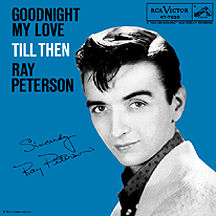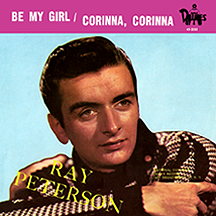RAY PETERSON
Ray Peterson was an emotional guy. Afflicted with polio as a child, one can understand why he might grow up with a more sensitive nature than the average person. Actually, he was a strong-willed kid, determined to fight back against the weakness the disease caused, primarily in his leg muscles. A gifted singer, he possessed a four-octave range, and while spending much of his childhood in a Texas hospital undergoing treatment, he sang for the other patients whenever possible. Gradually learning to get along quite well in spite of the disease, he nevertheless wore braces on his legs through childhood and most of his adult life. Deciding what path to take once he was 18, Ray pursued the obvious career in music, his promising vocal abilities securing him a record contract almost immediately with RCA Victor in 1957.
"Fever," the classic 1956 hit by Little Willie John, may have seemed like an unusual choice for Ray's first single release, but it was a solid effort with a haunting quality unlike anything he would do afterward. It didn't click, though, leaving a clear field for Peggy Lee's unique interpretation that became a smash in '58. Several attempts followed over the next couple of years with no results, but the label stuck with him and it paid off in the spring of 1959. Baker Knight, who wrote many of Ricky Nelson's hits and later penned several of Dean Martin and Frank Sinatra's mid-'60s efforts, composed "The Wonder of You" with longtime RCA star Perry Como in mind, but it was Peterson who wound up doing the session and notching his first hit in the process. The use of prominent string sections in pop and rock singles was a hot trend in '59, with string-drenched records by Brook Benton, The Drifters and RCA's Jesse Belvin hitting big, and it worked for "Wonder" too; heart-tugging strings interlaced with the emotional sincerity of Ray's voice was a winner. This approach was utilized on a follow-up single as well, a remake of Belvin's 1956 R&B hit for Modern Records, "Goodnight My Love."
Now that he had hit records on the charts, Ray's career took a big step forward, and live performance dates in bigger venues crowded his calendar. His limited mobility caused by polio presented a problem, and he practiced long hours training himself to move onstage as gracefully as possible. His next single, at the start of 1960, was a cover of the British hit "What Do You Want to Make Those Eyes at Me For?" which had just spent several weeks at number one in Britain for Emile Ford and the Checkmates, and the B-side, "Answer Me My Love," became his second appearance ("The Wonder of You" being first) on the U.K. charts. Then Mark Dinning came out with the chart-topping smash "Teen Angel" and the floodgates opened on a bizarre musical genre: "teenage death" songs, a morbid series of mini-soap operas that would capture the public's imagination for years to come. Peterson was the first artist, post-Dinning, to cash in big on the craze; with "Tell Laura I Love Her" (written by Jeff Barry and Ben Raleigh), his stirring vocals approaching tearfulness told of unrequited youthful romance leading to a desperate attempt at winning a stock car race offering a thousand-dollar first prize, with fatal consequences and lyrics that were simultaneously sentimental and grisly: '...his car overturned in flames, but as they pulled him from the twisted wreck, with his dying breath they heard him say...tell Laura I love her.' Like a race car punchin' it from 0 to 60, the record became his first top ten hit.
He'd thrown his hat into the teen arena and there would be no turning back, at least for the immediate future. But as good as 1960 had been, 1961 would be much better. At the end of his RCA Victor contract in the fall of '60, just after the sensation of "Tell Laura," Peterson and his manager Stan Shulman started their own record company, financing it with the proceeds from the hit record. Naming the label Dunes, after the Las Vegas hotel where Ray had frequently performed, Shulman suggested they take a chance on the relatively unproven Phil Spector to produce the first single.
Spector's number one debut with The Teddy Bears' "To Know Him, is To Love Him" was already two years past, during which time he'd been floating around the business, working the angles at Imperial, Atlantic and other companies, looking to unleash his next potential masterpiece on the world. Spector was anxious to work with a popular act like Ray Peterson and tackled the project with gusto. He decided to rework the 1956 Joe Turner hit "Corrine Corrina" (a song with country roots as far back as the 1920s) as a midtempo teen ballad with strings, feeling it would be a good fit with Peterson's emotive vocal style. He was right. The collaboration was pure magic in the studio and on the radio, as the slightly-retitled "Corinna, Corinna" became Ray's second top ten hit in less that six months (the flip, "Be My Girl," would be gender-adjusted for The Paris Sisters as "Be My Boy" by Spector a few months later, becoming the first single to hit the charts for the three singing siblings after several years in the business, though on the Gregmark label and not Dunes). Also hitting big in 1961 was Yuma, Arizona transplant Curtis Lee, who enjoyed a Spector-produced top ten single released on Dunes, "Pretty Little Angel Eyes."
Follow-up singles by Peterson included "Sweet Little Kathy" (which he co-wrote with up-and-coming songwriter Tommy Boyce), the Dale Noe-Red Sovine song "Missing You," which put Ray back in the top 30 in the fall of '61, and "I Could Have Loved You So Well," another Spector production. He also hit the charts with a song by hot husband-and-wife songwriting team Jeff Barry and Ellie Greenwich, "Give Us Your Blessing," a return to overdramatized teenage tragedy, which fared better as a top 40 hit remake for The Shangri-Las, a group more suited to the teen death syndrome, in 1965.
Around 1963, the Dunes label had run its course, and according to Peterson, his partner Stan Shulman had made off with the lion's share of the profits. In Phil Spector he found a shoulder to cry on, but little more from his producer friend, who by that time had a different agenda, the red-hot Philles label with its Phil-controlled smash artist roster. Ray then signed a contract with MGM Records and made a few very good, but underappreciated, records and by the start of 1965 was off the charts for good. From that point on he made a steady living in concert bookings, which he found personally satisfying, revelling in what for him was an unexpected positive reaction from fans to his emotion-filled performances. When Elvis Presley had his own hit version of "The Wonder of You" in 1970, there was renewed interest in the original artist's performances. Ray Peterson later became a Baptist minister, occasionally taking time off from spiritual endeavors to perform his hits for appreciative fans.
NOTABLE SINGLES:
- The Wonder of You - 1959
- Come and Get It - 1959
- Goodnight My Love - 1959
- What Do You Want to Make Those Eyes at Me For? /
Answer Me My Love - 1960 - Tell Laura I Love Her - 1960
- Corinna, Corinna /
Be My Girl - 1961 - I'm Tired - 1961
- Sweet Little Kathy - 1961
- Missing You - 1961
- I Could Have Loved You So Well - 1962
- Give Us Your Blessing - 1963
- Promises (You Made Now Are Broken) - 1964
- Oh, No! - 1964
- Across the Street (Is a Million Miles Away) - 1964



